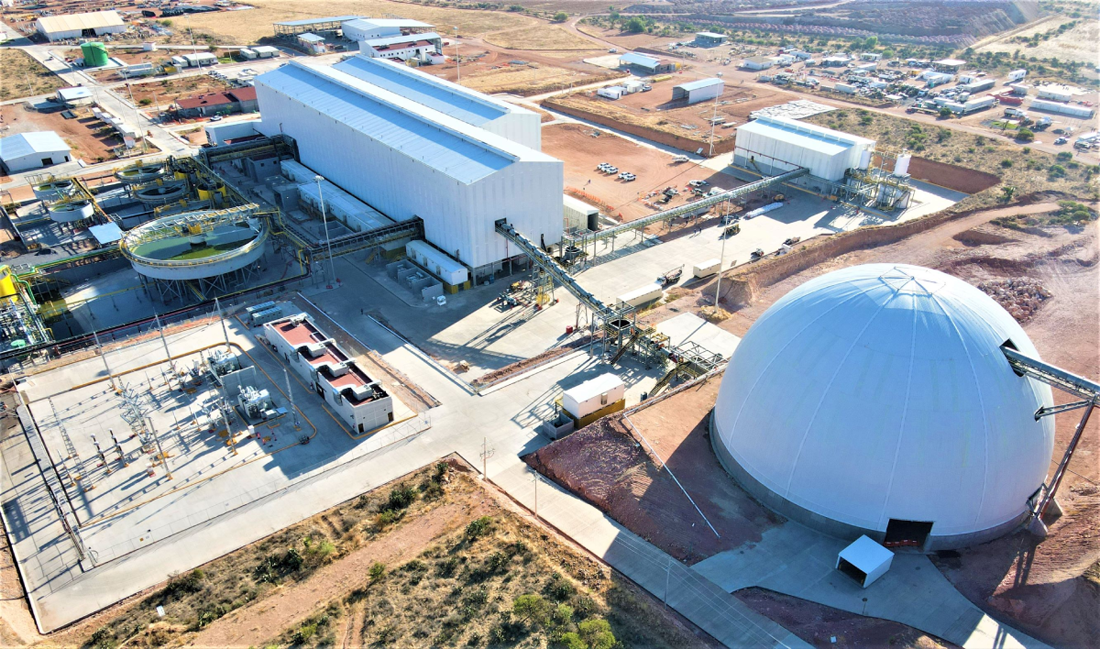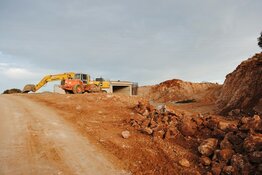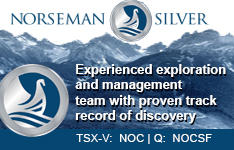Dakota Gold Corp. (DC:NYSE American) announced the discovery of important rare earth elements (REEs) at its Richmond Hill gold project in the historic Homestake District of South Dakota, which could open new economic and permitting opportunities for the company.
Preliminary evaluation from Dakota Gold’s exploration and development drilling program has identified the high-grade REEs within gold resource areas being defined in its upcoming maiden resource, scheduled for completion this quarter. The company noted REEs will not be included in the upcoming maiden resource, but "work has begun to characterize the distribution of (REEs) as well as the mineralogy which may be useful in assessing the potential economic contribution to the Richmond Hill Gold Project."
Preliminary evaluation of cores identified the high-grade REEs within gold resource areas being defined in its upcoming maiden resource, scheduled for completion this quarter.
REEs are vital in shifting the economy to cleaner energy, but China is responsible for two-thirds of current REE mine production and more than 85% of the refined output of REEs.
For that reason, the U.S. Department of Energy has announced more than US$200 million in grants for REE projects — US$32 million last July, US$30 million in August, and US$150 million in September. Dakota Gold also noted that "the United States has begun prioritizing the permitting of critical mineral exploration and mining projects."
"The U.S. Department of Defense and Department of Energy are prioritizing REEs — we think this discovery at Richmond Hill could help DC advance the asset with respect to permitting and potential non-dilutive government funding opportunities." — Analyst Michael Gray, Agentis Capital
"The US Department of Defense and Department of Energy are prioritizing REEs — we think this discovery at Richmond Hill could help DC advance the asset with respect to permitting and potential non-dilutive government funding opportunities," analyst Michael Gray of Agentis Capital wrote in a Jan. 31 research note.
Dakota Gold President and Chief Executive Officer Jonathan Awde told Streetwise Reports that in addition, the company hopes the discovery can augment the project's economics, reduce permitting timelines, and reach new investors.
"Can this expand our investor universe of people who would eventually care about Dakota Gold?" Awde said. "This could potentially open investor interest in Dakota Gold to those who follow REE companies."
"The overriding factor is that we think it can augment our gold endowment at Richmond Hill," he continued.
The Catalyst: Up to 12.9% Rare Earth Oxides Over 4.9 Feet
The global market for REEs is expected to grow from US$2.6 billion in 2020 to US$5.5 billion in 2028, according to a report by Fortune Business Insights.
"The rising demand for consumer durables such as tablets, laptops, and smartphones (are some) of the factors driving the consumption of rare earth elements," the report said. "The demand for these elements in developing economies is estimated to expand rapidly."
Dakota said cerium (used in TVs and light bulbs) and lanthanum (used for special optical glasses and petroleum refining) anomalies were first identified at Richmond Hill in 2023, and also noted significant concentrations of neodymium and praseodymium (maximum values over 1% combined) were present, said Patrick Malone, Dakota Gold's chief sustainability officer. "REE, particularly magnet REE like neodymium and praseodymium, are critical raw materials for many types of high technology — everything from smart phones to renewable energy and defense technologies," he said.
The results released Wednesday were confirmed to contain high levels of REEs, up to 12.9% of total rare earth oxides (REO) over 1.5 meters.
Other highlights include 3.5% TREO over 35.7 meters and 3.4% TREO over 17.5 meters in the same drill hole, 3.4% TREO over 30.2 meters in another hole, and 2.7 TREO over 23.2 meters and 3.8% TREO over 13.6 meters in a third.
"Can this expand our investor universe of people who would eventually care about Dakota Gold?" — Dakota Gold President and Chief Executive Officer Jonathan Awde
In the limited drilling, REO concentration over 1% occurs intermittently in an area 300 meters by 300 meters to a depth of 300 meters.
"These anomalies occur within the same area as previously reported gold mineralization at Richmond Hill," the company said.
"The geometries and continuity of the mineralizing system are unclear at this point," Gray from Agentis wrote. "We suspect it could be related to hydrothermal remobilization from a deeper host rock (carbonatite or syenite?) up through the Tertiary epithermal Twin Tunnels breccia pipe."
Gray also noted that Richmond Hill is about 45 kilometers east of Rare Element Resources Ltd.'s (REEMF:OTCQX ) Bear Lodge project in Wyoming.
"Bear Lodge is hosted in what is likely a part of a similar Tertiary intrusive suite," Gray noted.
Work Begins on Mineralogy at Richmond Hill
Dakota next plans to conduct more REE sampling using more sensitive analyses, conduct mineralogical studies, and refine the geometry and quantity of the various REOs, "particularly in relationship to a future anticipated gold mineral resource estimate."
"We are also evaluating the potential presence of xenotime as a source for the heavy REE dysprosium and terbium," the company said. "Neodymium, praseodymium, dysprosium, and terbium are all critical minerals in the Department of Energy's 2023 Critical Materials Assessment based on their high importance and high supply chain risk."
Dakota Gold is exploring the 46,000 acres it has acquired and consolidated over the past decade surrounding the Homestake Mine. Industry giant Barrick Gold Corp. (ABX:TSX; GOLD:NYSE) also backs the company.
Once called the "Richest 100 Square Miles" on Earth, the Homestake Mine was discovered in 1876 and consolidated by George Hearst. Over 126 years, miners extracted 41 million ounces gold (Moz Au) and 9 Moz silver (Ag) from the site.
However, much of the land owned by Dakota Gold has not been explored in nearly 30 years, leaving hope for another major discovery.
A Trade 'Cold War'
REEs are used for everything from purifying water, too MRIs, fertilizers, weapons, scientific research, wind turbines, computers, and permanent magnet motors for electric vehicles (EVs).
Developing a new mine can take years, and China has been escalating a standoff with the West, already putting restrictions on the exports of some of the substances. Last December, the communist country banned exporting technologies for processing REEs.
Jeff Green, a defense industry consultant and Washington lobbyist, told The Washington Post, "We're in a cold war essentially on the trade front now."
U.S. Secretary of Commerce Gina Raimondo warned recently, according to The Post, that "China has a head start, and that means we have to work a little harder and a little faster. They have the technology and sustained investment . . . to dominate the market for critical minerals, (which) can cause a great deal of pain very quickly."
 Streetwise Ownership Overview*
Streetwise Ownership Overview*
Dakota Gold Corp. (DC:NYSE American)
Ownership and Share Structure
According to the company, approximately 25% of its shares are with management and insiders.
Out of management, Co-Chairman Robert Quartermain holds the most shares at 8.5% or 7.34 million shares, Reuters said. President and CEO Jonathan Awde is next at 7.1%, with 6.18 million shares, while COO Jerry Aberle holds 4.8%, with 4.2 million. The remainder of the 25% is held by other members of management and the board of directors.
About 26% of the shares are with institutional investors, according to Yahoo Finance and Edgar filings. A few of the top institutional holders include Fourth Sail Capital with 5.3%, Van Eck Associates with 3.5%, Blackrock Institutional Trust Co. with 3.4%, The Vanguard Group Inc. with about 3%, Fidelity Management and Research Co. LLC with 2.9%, CI Investments, Inc. with 2.8%, and 1832 Asset Management LP with 2.4%.
About 16.5% is with strategic investors, including Barrick Gold Corp. (ABX:TSX; GOLD:NYSE), which owns about 3%. The rest is retail.
Dakota Gold has a market cap of US$186.93 million, with 86.74 million shares outstanding and about 67.47 million free-floating. It trades in a 52-week range of US$3.945 and US$2.00.
| Want to be the first to know about interesting Gold, Silver and Critical Metals investment ideas? Sign up to receive the FREE Streetwise Reports' newsletter. | Subscribe |
Important Disclosures:
- Dakota Gold Corp. is a billboard sponsor of Streetwise Reports and pays SWR a monthly sponsorship fee between US$4,000 and US$5,000.
- As of the date of this article, officers and/or employees of Streetwise Reports LLC (including members of their household) own securities of Dakota Gold Corp.
- Steve Sobek wrote this article for Streetwise Reports LLC and provides services to Streetwise Reports as an employee.
- This article does not constitute investment advice and is not a solicitation for any investment. Streetwise Reports does not render general or specific investment advice and the information on Streetwise Reports should not be considered a recommendation to buy or sell any security. Each reader is encouraged to consult with his or her personal financial adviser and perform their own comprehensive investment research. By opening this page, each reader accepts and agrees to Streetwise Reports' terms of use and full legal disclaimer. Streetwise Reports does not endorse or recommend the business, products, services or securities of any company.
For additional disclosures, please click here.


































